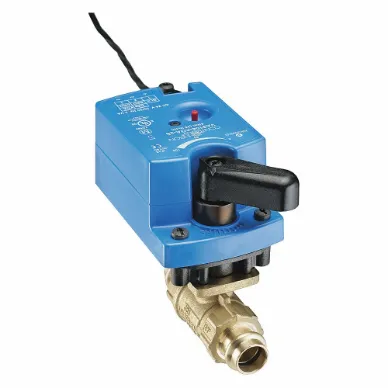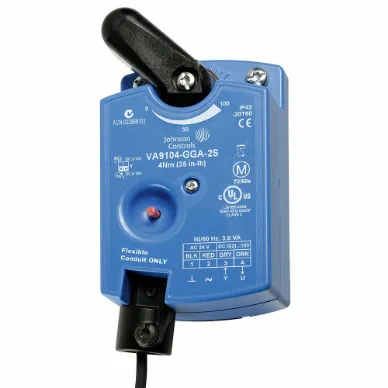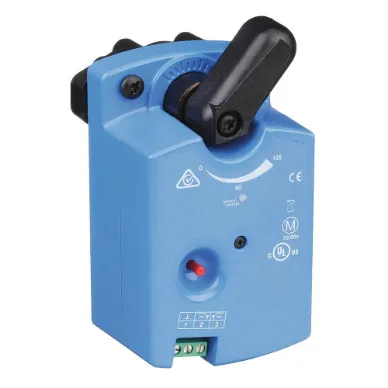Johnson Controls VA9104-GGA-3S electric non-spring valve actuator is used in HVAC and automation systems. It is ideal for precisely controlling the valve operation and regulating the air, water or fluid flow within heating, cooling and ventilation systems. This actuator offers a seamless integration solution with remote monitoring capabilities, enhancing comfort, optimising energy efficiency and streamlining overall operation.
Uses:
Johnson Controls VA9104-GGA-3S electric non-spring valve actuator is ideal for accurate positioning on ball valves in air conditioning, heating and ventilation applications.
Features:
- Johnson Controls VA9104-GGA-3S actuator has a NEMA 2 rated enclosure for safeguarding against light splashing water and dripping.
- It features a synchronous drive for constant rotation time independent of the connected load.
- This valve actuator has a durability of up to 100000 cycles and is rated at 35 dBA for minimum noise, meeting audible noise requirements.
- It has a single screw style direct mounting design for reduced installation and maintenance time.
- This VA9104-GGA-3S actuator offers a manual override for easy manual positioning of the ball valve.
- It is equipped with a flexible metal conduit connector, simplifying field wiring and installation.
- This valve actuator can be operated at temperatures ranging from -4 to 140 degrees F.
- It is integrated with a factory-mounted valve linkage, offering streamlined and accurate valve control for optimal system performance.
Compatible Accessories:
- Johnson Controls M9000-561 Thermal Barrier: This thermal spacer is used with VA9104-GGA-3S actuator to enable the inclusion of low-pressure steam in the application.
Standards and Approvals:
- Johnson Controls VA9104-GGA-3S electric non spring valve actuator is manufactured in compliance with CE and UL standards.
Installation:
Johnson Controls VA9104-GGA-3S electric non spring valve actuator is positioned & fixed onto the ball valve mounting flange, and the actuator handle is keyed onto the actuator. If the requirement is to mount the thermal barrier on the actuator, mount it before installing the ball valve. The drive shaft that connects the actuator to the ball valve is connected via a drive shaft. The drive shaft connects the ball valve to the actuator through the thermal barrier assembly. The ball valve is connected to system piping for completing the installation process. This valve features direct mount design that allows easy installation on top of the ball valve without complications. Johnson Controls VA9104-GGA-3S electric non spring valve actuator has a screw terminal style electrical connection for easily wiring the actuator.
Frequently Asked Questions:
Q. Can these actuators be connected to the electrical supply?
A. Yes, Johnson Controls VA9104-GGA-3S electric non spring valve actuators require electrical input for operation. These actuators have M3 screw terminals and can be quickly wired on-site. They require a 24VAC input signal, and work with a range of electrical controllers.
Q. What is the difference between non spring return & spring return actuators?
A. Non spring valves ideally require pressure to close or open the valves. Also, in the absence of air pressure, the valves remain in the position before the pneumatic supply disconnects. Spring return valves need pressure in a single direction and release of pressure in another direction.
Q. What is the difference between double and single acting actuators?
A. The double acting actuators use a piston as the primary element to operate the valve while single acting actuators use a combination of spring/membrane and control valve air output.
Q. How does an actuator work?
A. Valve actuators are components of machines that are responsible for controlling and moving certain mechanisms or systems, such as opening a valve. When these actuators receive a control signal, it responds by opening / closing the valve gate.
Q. What do Johnson Controls actuators do in a valve?
A. Johnson Controls VA9104-GGA-3S electric non-spring valve actuators control the opening and closing of valves. These actuators can provide either rotary or linear motion and work with a range of valves, including ball & butterfly valves.
Q. How do I clean and maintain this VA9104-GGA-3S valve actuator?
A.
- Turn off the power supply to the actuator.
- Gently remove the actuator cover using appropriate tools.
- Inspect for any visible dirt or debris on the exterior.
- Use a soft brush or compressed air to clean the surface.
- Check the valve and linkage for any obstructions or buildup.
- Wipe down the actuator housing with a damp cloth.
- Lubricate moving parts with recommended oil or grease.
- Reattach the cover securely for proper alignment.
- Power on the actuator and verify smooth operation.
- Regularly schedule maintenance checks to ensure continued performance.
Q. What factors should I consider while choosing a valve actuator?
A.
- Ensure the actuator matches your valve type.
- Match output with torque / thrust requirements.
- Confirm control signal compatibility.
- Choose a suitable power source and evaluate speed & response to fit process needs.
- Consider environmental factors like temperature and corrosion.
- Select enclosure rating for installation.
- Review safety features for added protection.
- Assess maintenance ease and lifespan.
- Ensure seamless integration with existing systems.
Q. What is the difference between non spring return & spring return actuators?
A. Spring return actuators use built-in springs to ensure a fail-safe return to a default position during power loss, making them ideal for safety-critical applications. Non-spring return actuators lack this spring mechanism and rely solely on continuous power for positioning. They are suitable for precise control scenarios where the immediate fail-safe return is not a priority.
 Change country
Change country





